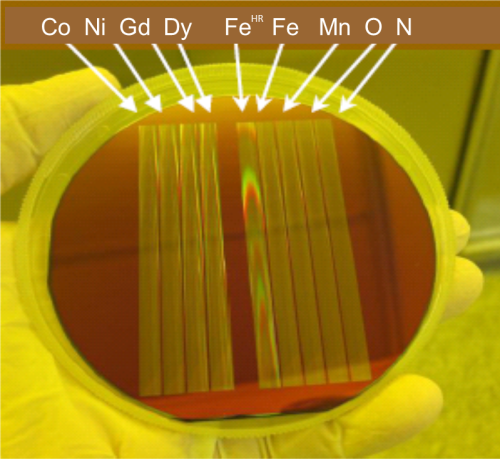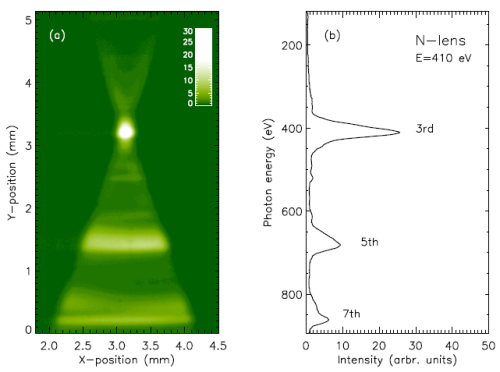Femtoslicing facility successfully upgraded: New opportunities in ultrafast x-ray science

The heart oft the new Zone-Plate monochromator for ultrafast
science with FEMTOSLICING is an array of
so-called reflection zone plates. These diffractive optical
elements cover the photon energy range from
410 to 1333 eV and are completely manufactured
in-house at HZB.
(courtesy A. Firsov, M. Brzhezinskaya).

CCD image oft the dispersion plane 5.08 m behind
the Nitrogen lens (N) at 410 eV emitted from
the 3rd harmonic oft the UE56/1 (a) and a corresponding
vertical linescan (b) showing up the 5th and 7th harmonics
off horizontal focus.
( © K. Holldack
Ultrashort X-ray pulses are an indispensable tool to visualize ultrafast processes in solids and liquids. In order to generate them at the BESSY II storage ring employing Femtoslicing, ultrashort laser pulses co-propoagate with the relativistic electrons in an undulator while exciting them to emit x-ray pulses of only 100 fs duration, a time range of atomic ordering phenomena in solids.
While Femtoslicing has been gradually upgraded over the past few years, in the recent upgrade it was all about a novel Zone Plate Monochromator (ZPM). This special high-flux beamline has been completely re-designed, built and commissioned in 2012 in a close collaboration between the Institute for Methods and Instrumentation in Synchrotron Radiation Research and the Institute for Nanometer Optics and Technology.
“After successful commissioning we can now state that all initially envisaged goals have been more than achieved: smaller focus, improved resolution and excellent long term stability. Current users are delighted”, says Dr. Karsten Holldack who has been heading up the Femtoslicing upgrade projects.
Together with the Top-Up mode of the storage ring and increased duty cycle of 6 kHz, a new class of exciting ultrafast applications with variable optical excitation wavelength can now be addressed.
Funding was kindly provided on a short term basis by internal funding via a strategic investment fund of the HZB.
https://www.helmholtz-berlin.de/pubbin/news_seite?nid=13644;sprache=en
- Copy link
-
Ernst Eckhard Koch Prize and Innovation Award on Synchrotron Radiation 2025
At the 27th BESSY@HZB User Meeting, the Friends of HZB honoured the dissertation of Dr Enggar Pramanto Wibowo (Friedrich-Alexander University Erlangen-Nuremberg). The Innovation Award on Synchrotron Radiation 2025 went to Prof. Tim Salditt (Georg-August-University Göttingen) and Professors Danny D. Jonigk and Maximilian Ackermann (both, University Hospital of RWTH Aachen University).
-
Synchrotron radiation sources: toolboxes for quantum technologies
Synchrotron radiation sources generate highly brilliant light pulses, ranging from infrared to hard X-rays, which can be used to gain deep insights into complex materials. An international team has now published an overview on synchrotron methods for the further development of quantum materials and technologies in the journal Advanced Functional Materials: Using concrete examples, they show how these unique tools can help to unlock the potential of quantum technologies such as quantum computing, overcome production barriers and pave the way for future breakthroughs.
-
MAX IV and BESSY II initiate new collaboration to advance materials science
Swedish national synchrotron laboratory MAX IV and Helmholtz-Zentrum Berlin (HZB) with BESSY II light source jointly announce the signing of a 5-year Cooperation Agreement. The new agreement establishes a framework to strengthen cooperation for operational and technological development in the highlighted fields of accelerator research and development, beamlines and optics, endstations and sample environments as well as digitalisation and data science.
